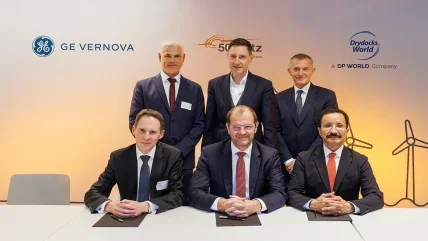
A consortium of GE Vernova and Drydocks World has been selected by German transmission system operator (TSO) 50Hertz to build a converter system for the 2GW Ostwind 4 offshore grid connection project in the Baltic Sea.
The project will establish a high-voltage direct current (HVDC) electric transmission system to connect offshore wind energy to the German national grid, supporting the country’s renewable energy ambitions under its Energiewende framework.
The consortium will deliver both the offshore converter platform and the onshore converter station required for the grid connection.
GE Vernova will lead the initiative, supplying advanced HVDC technology, including voltage-sourced converters (VSC), high-voltage transformers, and g3 gas-insulated switchgear (GIS).
The company will also handle civil works for the onshore converter station and provide grid automation and telecommunications equipment.
GE Vernova electrification business CEO Philippe Piron said: “Ostwind 4 represents a crucial milestone in our mission to electrify and decarbonise with the energy to change the world.
“By leveraging our advanced HVDC technology, this key infrastructure project underscores the essential role of offshore wind to ensure European energy security and to accelerate the global energy transition.”
Drydocks World will design, fabricate, and install the offshore converter platform, including the jacket substructure and topside.
The platform’s U-shaped jacket substructure will include integrated nature-inclusive scour protection, designed to support marine biodiversity while minimising environmental impact.
Located in the Arkona Basin, about 30km northeast of Rügen Island, the Ostwind 4 is the fourth offshore grid connection in the Rügen Island wind farm cluster, following Ostwind 1, 2, and 3. The project will feature a bipolar HVDC system operating at 525kV.
The infrastructure will transport wind-generated power to the mainland, providing renewable energy for approximately two million households.
Scheduled for completion by the end of 2031, the project is expected to contribute towards the country’s goal to phase out coal by 2030 and achieve net-zero emissions by 2045.
The Ostwind 4 project will connect an offshore wind farm situated in the northeast of Rügen Island, within the German Exclusive Economic Zone (EEZ).
A subsea cable of approximately 110km will run from the offshore converter through the Greifswald Bodden to Lubmin. From there, a 4km underground cable will extend to Brünzow, where a counter-converter will convert direct current (DC) back into alternating current (AC).
The electricity will then feed into 50Hertz’s extra-high-voltage transmission grid.
50Hertz CEO Stefan Kapferer said: “The awarding of the contract to GE Vernova and Drydock World marks the beginning of a new chapter in the use of wind energy in the Baltic Sea. 50Hertz is the first transmission system operator to deploy 2 GW / 525 kV technology in this sea area.
“This is pioneering work. We want to ensure that the entirety of the technically and economically viable offshore wind energy potential in the Baltic Sea is exploited, primarily with the help of direct current technology.”






